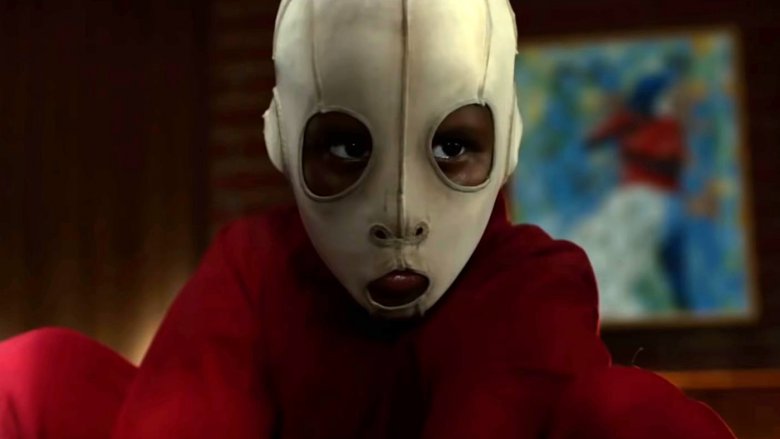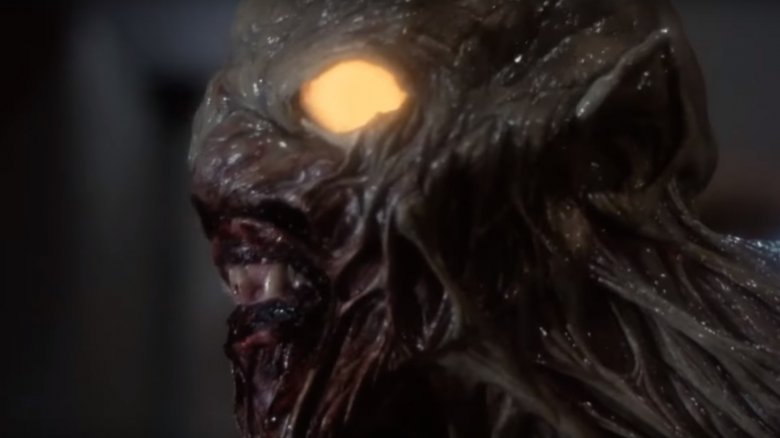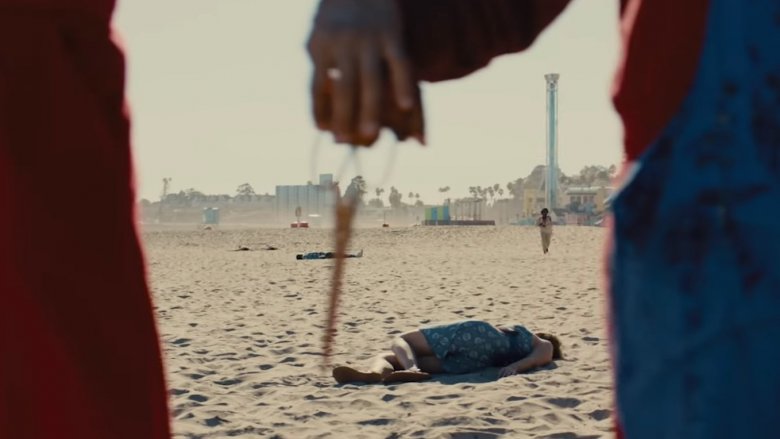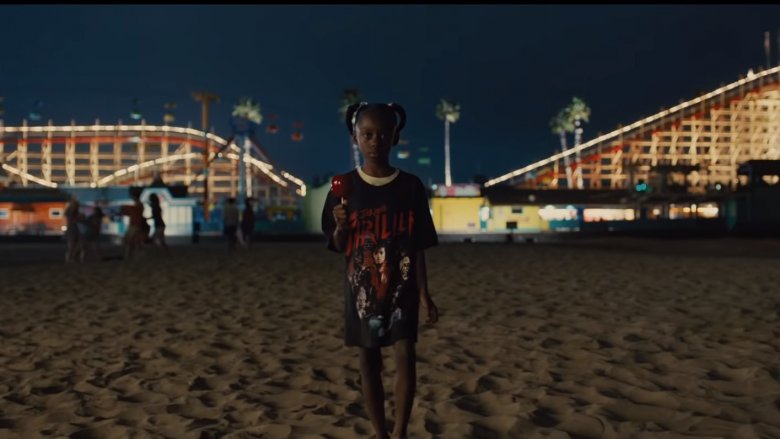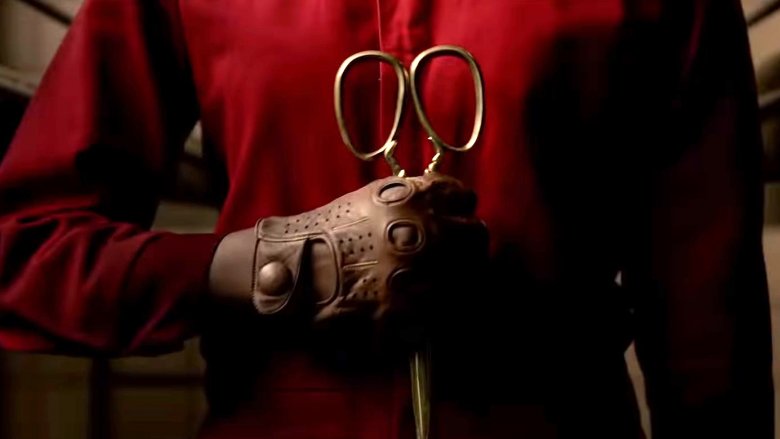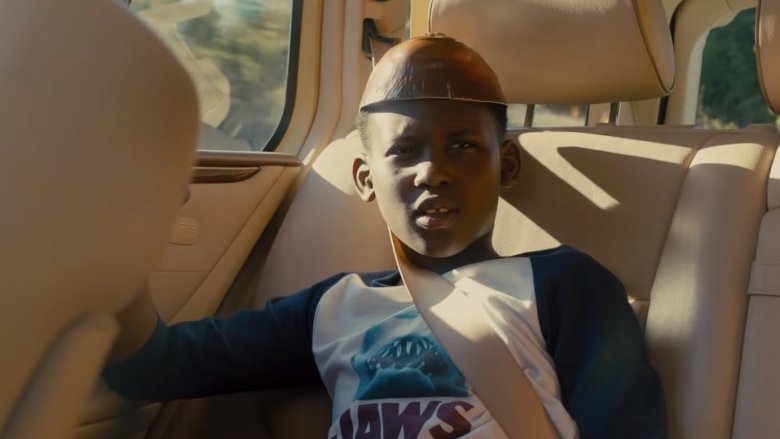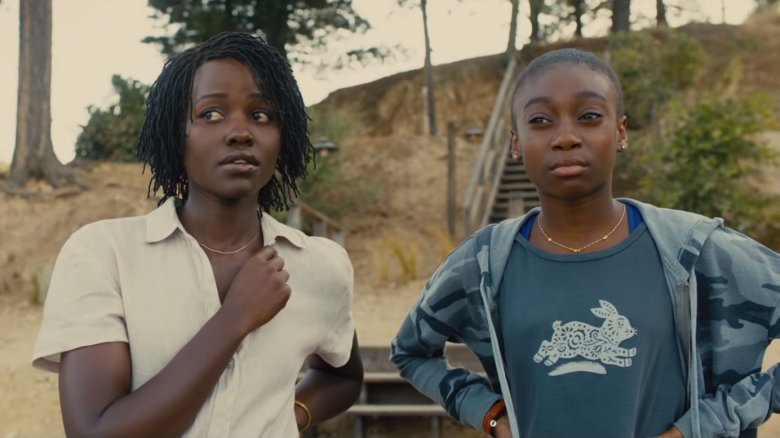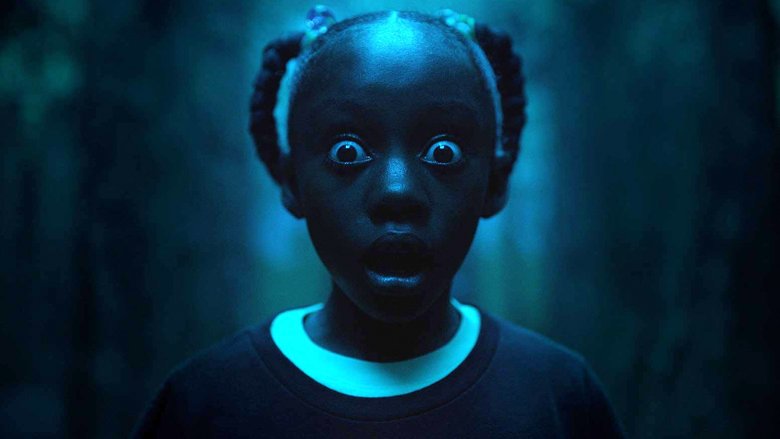Small Details You Missed In Us
Nobody expected Us, Jordan Peele's follow up to his award-winning social thriller Get Out, to be a simple slasher film, but Us is built on so many layers that it takes multiple viewings to unpack them all. Or, well, un-tether them all, if you catch our drift. On the surface, it's a movie about evil doppelgängers and all the horror scenarios you can dream up with that kind of premise. Plus scissors. Scissors suck.
But there are also other levels — from sociopolitical commentary down to the dynamic of basic family life — that turn Us into something worth watching again and again. Pile on top Peele's love of pop culture references, and you get a whole film's worth of small details that might get lost in a casual viewing. Have you seen Us? Are you ready to dig into all the Easter eggs and small details it had to offer? Get ready, because we're pulling apart the mysteries behind Us. Spoilers ahead.
VHS tracking
If you were paying attention, and weren't distracted by the guy beside you who was still trying to put his phone away after the trailers, you might have noticed that the entire plot of Us was spelled out in the opening seconds of the film.
After that long title shot with the rabbits, Us opens on a TV playing a weather report, followed by a commercial for the Hands Across America movement. (More on that in a second.) On either side of the TV are VHS tapes, including The Man with Two Brains, The Goonies, and C.H.U.D. It turns out that when you put those all together, you have Us.
In The Man with Two Brains, Steve Martin stars as a brain surgeon who telepathically connects with a disembodied brain in a jar. Like in Us, it deals with a mental connection between two physical forms. In The Goonies, of course, the Goonies end up trapped underground with seemingly no way out — just like the Tethered. One of the lines that Red, Adelaide's doppelgänger, says in the climax of the film actually comes directly from The Goonies. She says "It's our time. It's our time up there," while in The Goonies, Sean Astin's character Mikey says, "It's our time. It's our time down here."
Finally, C.H.U.D., or Cannibalistic Humanoid Underground Dwellers, deals with mutants living in the sewers under under New York City who begin attacking people on the surface. The parallels there are pretty obvious, cannibals or not.
Hands Across America
So what was up with all that hand-holding the Tethereds were into? In the climax, Red explained a bit of it, but if you weren't around in the '80s, you might not be familiar with the crazy charity stunt that The Washington Post has lovingly dubbed "the most Eighties thing to happen in the Eighties."
That charity stunt was Hands Across America, a 1986 event that tried to raise money for for the homeless by having people stand, hand in hand, across the entire United States. The premise was that we're all the same, and we're all connected, so why not pay $10 to make a countrywide umbilical with all your peers? Connect!
Peele has explained in interviews that he was heavily influenced by that moment (or, more accurately, by finding that commercial on YouTube), and it definitely shows in Us. One of the earliest scenes in the film includes that commercial. After that, the references pop up everywhere — young Adelaide is wearing a Hands Across America shirt under her Thriller tee when she's abducted, grown Adelaide uses the movement to organize her Tethered rebellion, and at the end, all the Tethered form a similar link across Santa Cruz — maybe even the whole country, for all we know. In the original charity event, it was for the homeless; in Us, it's for the weird underground clones. But the message is the same: "We won't be forgotten anymore."
Boardwalk vampires
In keeping with the partial '80s setting of Us and Peele's apparent love for the decade, there's one Easter egg that almost definitely slipped past anyone who isn't a diehard fan of the quintessentially '80s teen vampire flick The Lost Boys. (And let's be honest... that's pretty much everyone, right?)
Both movies used the Santa Cruz boardwalk as a filming location, but while The Lost Boys changed the town's name, Us was open about the film's setting. So open, in fact, that during the scenes taking place in 1986, it alluded to a real-life event that happened there: the filming of The Lost Boys.
While young Adelaide is walking with her parents, her mom tells her dad something along the lines of "They're filming a movie over by the carousel. Maybe you should try to be an extra." Peele confirmed in an interview that the line indeed referenced The Lost Boys, and most likely this scene of Kiefer Sutherland on a carousel.
The only way to hit that nail harder on the head would've been to have young Adelaide walk past the sexy jazz man. Oh, the things that could have been...
Sharp objects
You definitely noticed the scissors. Those golden implements of stabbiness were everywhere in Us — in hands, in bellies, in that one guy's crotch, in everything. And there's no doubt that scissors are scary horror weapons. They're sharp, they're in practically every home in the world, and they're an integral part of the scariest jump scene ever filmed. Ever.
That's pretty scary, right? Because scissors are scary. But in the Peele-iverse, as usual, there's a dual meaning to those golden scissors. Like the cutout paper people, the shadows as the family walks across the beach for the first time, and the house of mirrors, the scissors in Us are both separate and the same simultaneously. Peele himself explained it best when talking about the iconography he wanted to create with the scissors, saying, "The inherent duality of two equal objects that are connected, and an object that's used to sever or cut, is very important to the film."
Two separate parts, tethered together? You got us, Jordan Peele. You got us.
Deep connections
There are a lot of themes that run through Us, but the most apparent is purely horror-centric: the idea of creatures from the deep coming up to prey on surface dwellers. And the biggest nod to that came in the form of Jason's Jaws shirt that he wears during the car ride at the beginning of the film. There's clearly a lot of Jaws influence on Us. Aside from the idea of predators beneath us, the scenes on the beach are also reminiscent of Steven Spielberg's classic shark thriller.
Even one of the specific sequences — when Adelaide realizes that Jason is missing and suddenly sees all the innocent beach fun in a series of sharp, staccato, sinister moments — was pieced together a lot like the scene in Jaws in which Chief Brody is on the lookout for a shark before the big attack.
And sure, maybe it's a coincidence that both beach scenes had a similar vibe. But knowing what we know about Jordan Peele's taste for cinematic references, we're not betting on coincidence.
Zora's rabbits
More often than not, the clothing choices in Us speak louder than Gabe's empty threats to the creepy guys standing in his driveway. Jason wore a tuxedo t-shirt during the second half of the film, which also happened to be when he really matured as a character (sophisticated much?). But you also have to pay close attention to Zora's choices of wardrobe. Specifically, just about everything she wore had a rabbit on it. Even her green sweatshirt, which doesn't have a picture of a rabbit, is still printed with the word "thỏ," which is Vietnamese for rabbit.
Now, rabbits are all over Us, and we couldn't even begin to unpack all the meanings behind the rabbits in the film. As Jordan Peele explained to USA Today, "I can say just about any piece of symbolism that you could pull from the rabbit specifically I think is applicable to this story."
All those rabbits are an interesting fashion theme for a teenage girl, but it does fit her character. Remember, she's a runner, like a rabbit, and at one point she has to escape by running as fast as she can. Like, you know — a rabbit.
House of mirrors
In an interview with Rolling Stone, Peele revealed some of the inspiration behind his latest film, and it comes from an understandable place — The Twilight Zone, one of TV's oldest and best benchmarks for horror. In particular, Peele pulled inspiration from a 1960 episode titled " Mirror Image." Want to guess what it's about?
Yup — evil doppelgängers. In the episode, a woman at a bus station on a rainy night sees another person who looks exactly like her. As time goes on, she gets more and more agitated about it, until she's carted off by the police... at which point it's revealed that she wasn't crazy after all. The other woman was actually a mirror image from another dimension.
The obvious connection is there in Us by making the antagonists mirror images of the main characters, but Peele no doubt gave this an extra visual when he put Adelaide's first meeting with her Tethered in a literal house of mirrors (up to and including the conveniently placed sign that says "Find yourself" at the front door). In the closed world of that house of mirrors, the story plays out much like the Twilight Zone episode, especially at the end, when it turns out that Adelaide's mirror image is all too real, and has sinister plans of her own.
